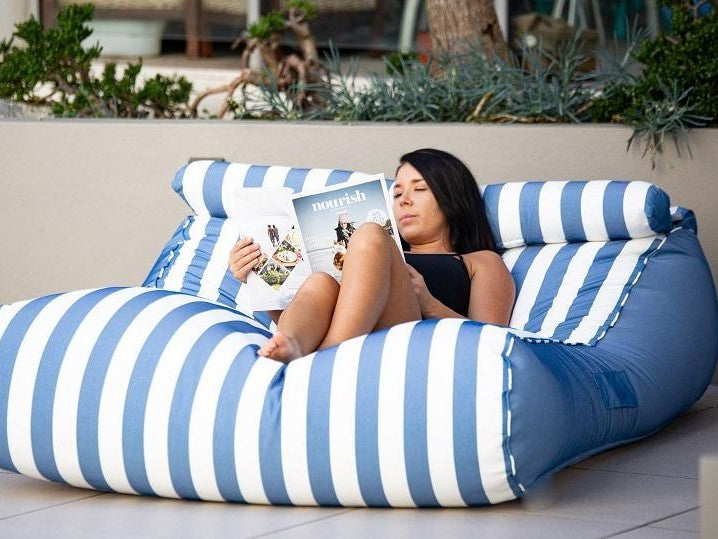10 Ways to Create a Relaxing Outdoor Space
Does it seem like your backyard is a place to avoid rather than a place to spend time?
Tired of feeling cooped up in the house?
Need somewhere to ditch the stress and just Zen out?
This article is for you. We’re going to walk you through exactly how you can create a relaxing outdoor space – regardless of whether you’ve got an apartment balcony, a grassy backyard, or a resort-style pool.
Keep reading, and you’ll learn about the four keys to relaxation, plus 10 practical tips that you can use to transform any outdoor area into a temple of relaxation. Ready to get into it?
Contents
|
What Does ‘Relaxing’ Mean?
Before we find out how you can create a relaxing outdoor space, let’s talk about what that actually looks like. ‘Relaxing’ means different things to different people. For one person, it might mean a day sprawled by the beach, listening to the pounding waves. For someone else, it might be the solitude of a bushland mountain.
There are a few elements, though, that every version of ‘relaxing’ has in common – the four keys to relaxation.
- Privacy. Almost everyone relaxes better when they’re with their loved ones or completely alone – it’s pretty hard to switch off when you’re in a roomful of people.
- Comfort. Discomfort – whether it’s a hard chair or a humid room – makes it more difficult for your body to relax, so it’s important to be as comfortable as possible.
- Low-arousal sights and sounds. Our bodies are hard-wired to become more alert when we see or hear certain things; for example, the colour red captures and holds our attention much more than other colours, just as loud noises can startle us into hypervigilance.
- Being in nature. Extensive research has proven that being in nature helps reduce cortisol, the stress hormone, and boost endorphin and dopamine levels, two hormones that promote happiness. Other notable effects include improved concentration, better creativity, and better sleep.
When you’re thinking about creating a truly relaxing outdoor space, make sure you include as much of each element as possible. Regardless of where you live or what your backyard looks like, maximising privacy, comfort, low-arousal sights and sounds, and plant life will help turn just about anywhere into a Zen-like paradise.
10 Ways to Create a Relaxing Outdoor Space
1. Create Privacy
Privacy is one of the four keys to relaxation, so it’s a great place to start when you’re designing a peaceful outdoor space.
Start by choosing an area that already has inherent privacy – for most people, a fenced backyard works well.
Next, do whatever you need to do to create a sense of shelter and isolation. This can mean planting thick shrubs that are slightly taller than your backyard fence, using hedges to hide your front yard from the road, or strategically blocking lines-of-sight from taller buildings with trees or wooden structures.
If you live in an apartment with a balcony, it can be worth putting up privacy screens or using thick pot plants to shield yourself from prying eyes.
2. Nurture Greenery
Plants are the most crucial element in any outdoor space. They’re essential to unlocking the mental benefits of being in nature, but they can also have other positive effects, including helping to purify your air, providing shade, and simply looking beautiful.
When you’re choosing plants to keep around your outdoor space, here are a few good points to think about.
- How committed are you to maintaining your plants? If you want a hassle-free space, pick shrubs and trees that don’t need a lot of water or fertiliser. Native plants and cacti are both great choices.
- Do you want pot plants or ground-based plants? Pot plants are more convenient – and ideal for urban living – but they typically need more attention, are more expensive, and can take up a lot more space per plant.
- What type of ambience do you want to create? Choose plants that go with your outdoor space’s theme.
- Will your plants drop lots of leaves or sticks? Although ‘messy’ plants can be great for encouraging wildlife to share your outdoor space, they aren’t always the best choice for very small spaces.
- Do your plants attract biting insects? Nothing disturbs your inner peace more than a cloud of hungry mosquitoes.
3. Add Shade
Remember how we named ‘comfort’ as one of the four keys to relaxation? In Australia, getting too hot is a real concern, especially over summer.
You can help keep your outdoor space cool, comfortable and usable by adding shade. Umbrellas are a simple and easy go-to, but you can also use tall shrubs, leafy trees, gazebos and balconies to keep the sun away.
Keep in mind that you don’t want your space to be too dark. Excessively shaded areas are prone to moss, mould and mosquitoes, and can be unpleasant to use in winter. Instead, aim for an area that balances sun patches with cool, sheltered spots.
4. Declutter
You’ve probably come across those sleek-covered decluttering books that somehow always make into bookshops and online stores. Decluttering has been popular for years, but it’s a trend with a real purpose.
Removing unused objects creates more space, which leads to more room and a better overall aesthetic – both of which can help you feel more relaxed. If you’re looking for things to throw out or give away, start with any non-essential furniture or objects that you haven’t used in a year or more.
You can also use the Konmari method as a litmus test; if the object in question doesn’t spark joy, get rid of it. Cracked tables, creaky chairs, old pool toys from when the kids were little – your time is up!
5. Choose a Theme
Beauty is subjective, but, for most people, it involves symmetry and cohesiveness. When you’re designing your relaxing space, aesthetics matter because ugliness is jarring – it shocks rather than soothes.
One of the easiest ways to create a beautiful space is to choose a single theme. By selecting one style, you can choose plants and furniture that complement each other, creating a more unified area that feels peaceful to be in.
You can explore common backyard themes here and here.
6. Use the Land
If you have a bigger backyard or you’re in the process of building a new property, think about how you can use the natural landscape to enhance the relaxed feel of your outdoor space.
For example, the north side of a house is typically the hottest, so you might get more shade by creating a space to the south of your house. Alternatively, if you live in a colder part of Australia, the north side might be better because of its warmth and light during winter.
There might also be certain points on your property that have beautiful views or get pleasant breezes – use them!
7. Add Comfortable Seating
Being comfortable is essential for true relaxation, but good outdoor seating is always difficult. Most people enjoy sprawling on a couch, but there’s no way you want your $1,000 leather baby sitting out in the elements.
The best alternative? Outdoor beanbags. Because beanbags cradle your body, they’re ideal for resting in the super relaxing ‘zero gravity’ position – butt pointed down, head and knees elevated slightly above your heart – which has a number of excellent physiological benefits.
Unlike chairs and benches, beanbags don’t have any hollows or gaps, so you won’t have to worry about spiders or any other creepy crawlies making nests in them. They’re also easy to just pick up and plonk anywhere – a beanbag feels as comfy next to a pool as it does parked on the lawn or under a tree.
Oh, and if you buy an Epona Co. beanbag, you’ll be purchasing one of the most durable outdoor beanbags on the market. Our outdoor options are made with olefin, a powerful synthetic fibre that’s resistant to mould, stains, sunlight, fire and chemicals, and is capable of maintaining its high strength in wet or dry conditions.
Each bag even features our patented Flowtex™ draining system, which allows moisture to drain out of the bag and is abrasion resistant to harsh concrete surfaces. There’s really no reason not to make a beanbag or two part of your outdoor Zen space, especially if you’re the type of person who loves to kick back with headphones or a good book.
Have you explored the Epona Co. outdoor bean bag range?
8. Add Functional Features
This tip isn’t for everyone, but, if you’ve got the space, money, and inclination to create a functional outdoor area, think about some useful features you can add.
The obvious addition is a pool or a spa. In summer, a pool can be the difference between lying in a puddle of sweat and feeling pleasantly relaxed. During winter, on the other hand, a spa can be a great place to kick back, have a few drinks, and watch the sun set. If you’ve got a floating bean bag or aquatic bean bag, you can even turn your pool into a beautiful place to read a book or have a snooze.
A fire pit can also be an awesome feature, especially if you love sitting outside at night in winter. Other great additions include hammocks and outdoor bean bags.
9. Use the Right Lighting
Yes, lighting matters. Harsh white light is a great way to stimulate your senses – not ideal when you’re trying to calm down and decompress. If you want to use your outdoor space at night, try making use of candlelight or light dimmers.
10. Use Fragrant Plants
Although sight and hearing are our most stress-oriented senses, certain smells can also reduce stress and invoke calmness.
Herbs like peppermint, lavender and jasmine have pleasant, relatively mild scents that many people find relaxing. All three also happen to be aesthetically pleasing, and can be used in a range of teas and household recipes – there’s really no reason not to have a couple of pot plants scattered around!
Other plants have fragrant flowers that look and smell great. Red boronias, native frangipanis, and lemon myrtles are all attractive native plants with sweet, soothing smells.
Remember not to plant too many fragrant plants close together – if they’re seasonal flowerers, their smell can become overwhelming at certain times of the year.
Summary
Ready to start creating a relaxing outdoor space? Regardless of how you decide to do it, keep in mind that the most soothing areas always have these four traits:
- Privacy
- Comfort
- Low-arousal sights and sounds
- Nature
To help your outdoor space become as peaceful as possible, use the 10 tips we suggested:
- Create privacy
- Nurture greenery
- Add shade
- Declutter
- Choose a theme
- Use the land
- Add comfortable seating
- Add functional features
- Use the right lighting
- Use fragrant plants
We’d love to see how these tips worked out for you, so please email us or tag us on your socials if you’ve got some pictures you’d like to share. Good luck!













